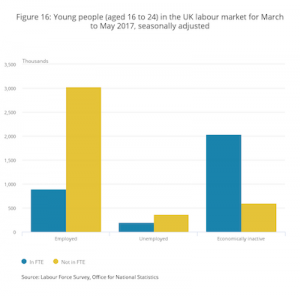The latest ONS data shows the employment rate at 74.9%, at its highest since comparable records began. The data available covers the period from March 2017 – May 2017.
The figures show that the number of people in work increased, the number of those unemployed fell and the number of people aged 16 – 24 not seeking or available to work (economically inactive) also fell.
We take a look at the headlines and the youth unemployment figures in more detail.
The Headlines
- There were 32.01 million people in work, 175,000 more than for December 2016 to February 2017 and 324,000 more than for a year earlier.
- The employment rate (the proportion of people aged from 16 to 64 who were in work) was 74.9%, the highest since comparable records began in 1971.
- There were 1.49 million unemployed people (people not in work but seeking and available to work), 64,000 fewer than for December 2016 to February 2017 and 152,000 fewer than for a year earlier.
- The unemployment rate (the proportion of those in work plus those unemployed, that were unemployed) was 4.5%, down from 4.9% for a year earlier and the lowest since 1975.
- There were 8.83 million people aged from 16 to 64 who were economically inactive (not working and not seeking or available to work), 57,000 fewer than for December 2016 to February 2017 and 55,000 fewer than for a year earlier.
Youth Employment Figures
 Within this data set young people are defined as those aged 16 – 24. Young people in full-time education are included in the employment estimates if they have a part-time job and are included in the unemployment estimates if they are seeking part-time work.
Within this data set young people are defined as those aged 16 – 24. Young people in full-time education are included in the employment estimates if they have a part-time job and are included in the unemployment estimates if they are seeking part-time work.
For March to May 2017, for people aged from 16 to 24, there were:
- 3.92 million people in work (including 890,000 full-time students with part-time jobs)
- 562,000 unemployed people (including 197,000 full-time students looking for part-time work)
- 2.64 million economically inactive people, most of whom (2.04 million) were full-time students
For March to May 2017, the unemployment rate for 16 to 24 year olds was 12.5%, lower than for a year earlier (13.5%).
The unemployment rate for those aged from 16 to 24 has been consistently higher than that for older age groups. Since comparable records began in 1992:
- the lowest youth unemployment rate was 11.6% for March to May 2001
- the highest youth unemployment rate was 22.5% for late 2011







